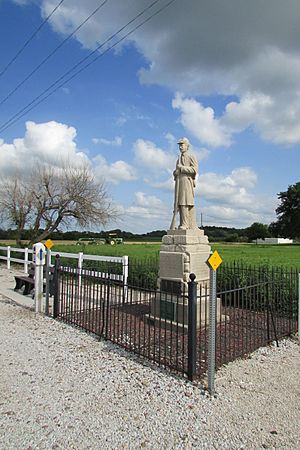Fort McPherson, Nebraska facts for kids
Fort McPherson was an important U.S. Army base built a long time ago during the American Indian Wars. It was first called Cantonment McKean, but many people knew it as Fort Cottonwood. This fort was located in what was then the Nebraska Territory, near where the city of North Platte, Nebraska is today.
Contents
Where Was Fort McPherson Located?
Fort McPherson was built right on the banks of the North Platte River. It was at the entrance of Cottonwood Canyon. This spot was very important because it was close to where the South and North Platte Rivers met.
A special place called Cottonwood Springs was also nearby. This was a natural spring, which means water came up from the ground. It was the only spring for many miles along the river. Because of this, it was a favorite stopping place for plains Indians. The canyon itself provided wood for fires and a safe place to hide. It also offered a good path for travel to the south.
Why Was Fort McPherson Built?
The decision to build Fort McPherson came after the Dakota War of 1862. The main goal was to protect travelers using the Oregon Trail and California Trail. These trails were busy routes for people moving west. The fort helped keep peace with the local Native American tribes. It also aimed to stop the movement of some Indian groups through Cottonwood Canyon.
History of Fort McPherson
Troops from the 7th Regiment Iowa Volunteer Cavalry built the fort. They used strong cedar logs cut from Cottonwood Canyon. The fort was finished in October 1863.
It was first named Cantonment McKean. But on February 26, 1866, its name was changed to Fort McPherson. This was to honor Major General James B. McPherson, an important army leader. Even with the new name, many people still called it Fort Cottonwood.
Important Events at the Fort
Many army missions started from Fort McPherson during the Indian Wars. One very important mission was led by General Eugene Asa Carr. This mission ended with the defeat of the Cheyenne Indians at the Battle of Summit Springs.
In 1873, Captain Charles Meinhold and his small group from the fort were the first to explore Massacre Canyon. They went there after a big battle between the Pawnee and Sioux tribes. An army doctor named David Franklin Powell wrote about finding many Pawnee warriors who had died.
The fort was no longer needed and was closed down in 1880.
Fort McPherson National Cemetery
A cemetery was created when the fort was built. In 1873, a larger area of about 20 acres (81,000 square meters) was set aside for the Fort McPherson National Cemetery. All the soldiers and others buried in the original fort cemetery were moved to this new, bigger cemetery.


